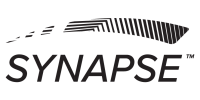All scans are conducted from their respective scan screens, which allow you to control the instrument and see the data that it is picking up in real time.
There are a few things to keep in mind when performing an EMG scan:
- Each sensor has three contacts. Much like a three pronged plug, the lowest contact is the ground. When taking a spinal contact, touch the upper two contacts across a spinal muscle belly and then touch the bottom sensor to ground the connection.
- If the scanning range needs to be expanded due to spasticity in the muscle being tested, the normal 25uV range can be expanded up to 100uV. To change this, simply touch on the left or right frequency graphs and choose the desired frequency level. Note: this does not alter the sensitivity of the collection. It merely gives you a larger window to view the Red and Blue line activity.
- You may grip under the two sensors and squeeze them together to get better angular position when scanning narrow spines in children and adults.
- If a segment reading needs to be rescanned due to an inaccurate collection, a scan can be easily re-done. Click on the “redo last segment” button. The protocol will ask you to confirm the segment on the handheld matches the segment on the screen. You can confirm or restart the scan. (Fig. 1)
- To get an accurate reading at each level:
- Touch the sensors to the patient’s skin at the current level.The contact should only be strong enough to indent the skin. Any more than this can push the patient forward.
- Continue to watch the iPad screen at each spinal level to ensure that the red and blue lines reach a parallel position
- The scan screen should say “Scan Ready” and not “Calculating” before you pull the trigger. This assures that the pace of scanning from segment to segment is controlled.
- Pull the trigger when the red and blue lines have been parallel for 1-2 seconds and the screen says “Scan Ready”. (Fig. 2)
- Alternately, you can watch the small screen on the neuroCORE to see the same lines as the one on your device’s screen. You’ll also see green and red lights on the neuroCORE’s screen. When both the lights turn green after the lines have been parallel to each other for a short amount of time, pull the trigger.
- To begin the assessment, start at S1 and follow the above guidelines to get an accurate reading. Then, you will be prompted to move to the next level in the protocol, continuing this sequence up the spine until you get up to the neck.
- The scan screen should say “Scan Ready” and not “Calculating” before you pull the trigger.
- To scan the neck:
- A special “narrowing” feature is available when scanning the neck.
- A unilateral sequence begins automatically at the C7 default level (this can be changed easily to whichever is the best level for that patient: narrow necks may require an earlier starting level). It is NOT necessary to use unilateral collection here.
- Place the LEFT sensor on the LEFT spinal level being prompted. Pull the trigger, adhering to the collection guidelines above. Then you will be prompted to do the same on the RIGHT side using the RIGHT sensor up until C2.
- At C1, unilateral collection is ALWAYS necessary. Place the LEFT sensor over the LEFT lateral C1 position and get the reading, and then do the same on the RIGHT side with the RIGHT sensor.
 Fig. 1
Fig. 1 Fig. 2
Fig. 2Dr. Fletcher’s Pro Tips:
A note about children, ranging from newborns to age 13:
- An EMG can only be accomplished when the child can sit upright and stay calm for the duration of the test.
- Skilled examiners can do EMG scans accurately from 3 years of age and older.
- Fewer spinal segments are required with a children’s EMG scan to calculate the final CORESCORE.



